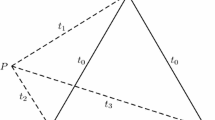Abstract
We study simplices whose vertices lie on a lattice and have no other lattice points. Such ‘empty lattice simplices’ come up in the theory of integer programming, and in some combinatorial problems. They have been investigated in various contexts and under varying terminology by Reeve, White, Scarf, Kannan and Lovász, Reznick, Kantor, Haase and Ziegler, etc.
Can the ‘emptiness’ of lattice simplices be ‘well-characterized’? Is their ‘lattice-width’ small? Do the integer points of the parallelepiped they generate have a particular structure?
The ‘good characterization’ of empty lattice simplices occurs to be open in general ! We provide a polynomial algorithm for deciding when a given integer ‘knapsack’ or ‘partition’ lattice simplex is empty. More generally, we ask for a characterization of linear inequalities satisfied by the lattice points of a lattice parallelepiped. We state a conjecture about such inequalities, prove it for n ≤ 4, and deduce several variants of classical results of Reeve, White and Scarf characterizing the emptiness of small dimensional lattice simplices. For instance, a three dimensional integer simplex is empty if and only if all its faces have width 1. Seemingly different characterizations can be easily proved from one another using the Hermite normal form.
In fixed dimension the width of polytopes can be computed in polynomial time (see the simple integer programming formulation of Haase and Ziegler). We prove that it is already NP-complete to decide whether the width of a very special class of integer simplices is 1, and we also provide for every n ≥ 3 a simple example of n-dimensional empty integer simplices of width n − 2, improving on earlier bounds.
Research developed partly during a visit in the Research Institute for Mathematical Sciences, Kyoto University.
Access this chapter
Tax calculation will be finalised at checkout
Purchases are for personal use only
Preview
Unable to display preview. Download preview PDF.
Similar content being viewed by others
References
W. Banaszczyk, A.E. Litvak, A. Pajor, S.J Szarek, The flatness theorem for non-symmetric convex bodies via the local theory of Banach spaces, Preprint 1998.
A. Barvinok, A polynomial time algorithm for counting integral point in polyhedra when the dimension is fixed, Math. Oper. Res., 19 (1994), 769–779.
J.W.S. Cassels, An Introduction to the Geometry of Numbers, Springer, Berlin, 1959.
W. Bienia, L. Goddyn, P. Gvozdjak, A. Sebő, M. Tarsi, Flows, View Obstructions, and the Lonely Runner, J. Comb. Theory/B, Vol 72, No 1, 1998.
C. Haase, G. Ziegler, On the maximal width of empty lattice simplices, preprint, July 1998/January 1999, 10 pages, European Journal of Combinatorics, to appear.
R. Kannan, L. Lovász, Covering minima and lattice-point-free convex bodies, Annals of Mathematics, 128 (1988), 577–602.
L. Lovász and M. D. Plummer, Matching Theory, Akadémiai Kiadó, Budapest, 1986.
J-M. Kantor, On the width of lattice-free simplices, Composition Mathematica, 1999.
H.W. Lenstra Jr., Integer programming with a fixed number of variables, Mathematics of Operations Research, 8, (1983), 538–548.
B. Reznick, Lattice point simplices, Discrete Mathematics, 60, 1986, 219–242.
J.E. Reeve, On the volume of lattice polyhedra, Proc. London Math. Soc. (3) 7 (1957), 378–395.
H. Scarf, Integral polyhedra in three space, Math. Oper. Res., 10 (1985), 403–438.
A. Schrijver, ‘Theory of Integer and Linear Programming’, Wiley, Chichester, 1986.
A. Sebő, Hilbert bases, Caratheodory’s theorem and Combinatorial Optimization, IPCO1, (R. Kannan and W. Pulleyblank eds), University of Waterloo Press, Waterloo 1990, 431–456.
G. K. White, Lattice tetrahedra, Canadian J. Math. 16 (1964), 389–396
Author information
Authors and Affiliations
Editor information
Editors and Affiliations
Rights and permissions
Copyright information
© 1999 Springer-Verlag Berlin Heidelberg
About this paper
Cite this paper
Sebő, A. (1999). An Introduction to Empty Lattice Simplices. In: Cornuéjols, G., Burkard, R.E., Woeginger, G.J. (eds) Integer Programming and Combinatorial Optimization. IPCO 1999. Lecture Notes in Computer Science, vol 1610. Springer, Berlin, Heidelberg. https://doi.org/10.1007/3-540-48777-8_30
Download citation
DOI: https://doi.org/10.1007/3-540-48777-8_30
Published:
Publisher Name: Springer, Berlin, Heidelberg
Print ISBN: 978-3-540-66019-4
Online ISBN: 978-3-540-48777-7
eBook Packages: Springer Book Archive




